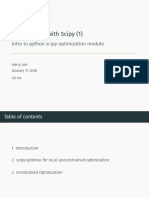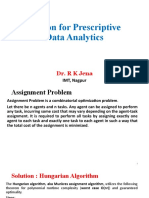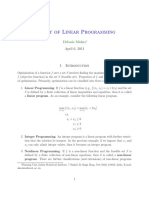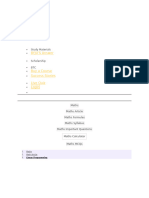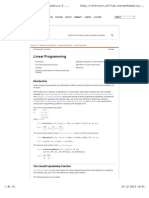The Problem Can Be Translated Into Python With The
Uploaded by
hachanThe Problem Can Be Translated Into Python With The
Uploaded by
hachanThe problem can be translated into Python with the pulp package, as follows:
In [ ]:
"""
A simple linear optimization problem with 2 variables
"""
import pulp
x = pulp.LpVariable('x', lowBound=0)
y = pulp.LpVariable('y', lowBound=0)
problem = pulp.LpProblem(
'A simple maximization objective',
pulp.LpMaximize)
problem += 3*x + 2*y, 'The objective function'
problem += 2*x + y <= 100, '1st constraint'
problem += x + y <= 80, '2nd constraint'
problem += x <= 40, '3rd constraint'
problem.solve()
The LpVariable function declares a variable to be solved. The LpProblem function initializes
the problem with a text description of the problem and the type of optimization, which in
this case is the maximization method. The += operation allows an arbitrary number of
constraints to be added, along with a text description. Finally, the .solve() method is called
to begin performing linear optimization. To show the values solved by the optimizer, use
the .variables()method to loop through each variable and print out its varValue.
The following output is generated when the code runs:
In [ ]:
print("Maximization Results:")
for variable in problem.variables():
print(variable.name, '=', variable.varValue)
Out[ ]:
Maximization Results:
Outcomes of linear programs
There are three outcomes in linear optimization, as follows:
• A local optimal solution to a linear program is a feasible solution with a closer objective
function value than all other feasible solutions close to it. It may or may not be the global
optimal solution, a solution that is better than every feasible solution.
• A linear program is infeasible if a solution cannot be found.
• A linear program is unbounded if the optimal solution is unbounded or is infinite.
You might also like
- Maximization Problem: Let Us Consider The Following Maximization Problem To Be SolvedNo ratings yetMaximization Problem: Let Us Consider The Following Maximization Problem To Be Solved2 pages
- Optimization Using Python: Dr. R K JenaNo ratings yetOptimization Using Python: Dr. R K Jena17 pages
- Chapter 2 - Linear Programming (Part 3 - Python)No ratings yetChapter 2 - Linear Programming (Part 3 - Python)18 pages
- Solving Linear Programming Using Python PuLP - Machine LearningNo ratings yetSolving Linear Programming Using Python PuLP - Machine Learning13 pages
- LAB0 UPDATED Converted - Compressed PDFNo ratings yetLAB0 UPDATED Converted - Compressed PDF20 pages
- Unit 1 - Operation Research and Supply Chain - WWW - Rgpvnotes.inNo ratings yetUnit 1 - Operation Research and Supply Chain - WWW - Rgpvnotes.in30 pages
- Steps To Solve A Linear Programming Problem - SuperprofNo ratings yetSteps To Solve A Linear Programming Problem - Superprof11 pages
- Or Unit 1 Long 1 Ans: Characteristics of Operations ResearchNo ratings yetOr Unit 1 Long 1 Ans: Characteristics of Operations Research9 pages
- Lesson - Linear Programming - An IntroductionNo ratings yetLesson - Linear Programming - An Introduction26 pages
- Chapter 3 - Deriving Solutions From A Linedeear Optimization Model PDFNo ratings yetChapter 3 - Deriving Solutions From A Linedeear Optimization Model PDF40 pages
- TP: Optimization Master 1 FMP + CM: Fboumediene@usthb - DZ Faiza - Boumediene@usthb - Edu.dzNo ratings yetTP: Optimization Master 1 FMP + CM: Fboumediene@usthb - DZ Faiza - Boumediene@usthb - Edu.dz13 pages
- Linear Programming-Wolfram Mathematica 9 ..No ratings yetLinear Programming-Wolfram Mathematica 9 ..15 pages
- Kelompok 2 - Linear Programming (English)No ratings yetKelompok 2 - Linear Programming (English)37 pages
- A Brief Introduction to MATLAB: Taken From the Book "MATLAB for Beginners: A Gentle Approach"From EverandA Brief Introduction to MATLAB: Taken From the Book "MATLAB for Beginners: A Gentle Approach"2.5/5 (2)
- Sakho I. Introduction To Quantum Mechanics 2. 2020 PDFNo ratings yetSakho I. Introduction To Quantum Mechanics 2. 2020 PDF297 pages
- Water Tank 10,000 L 10 Control Panel: Top ViewNo ratings yetWater Tank 10,000 L 10 Control Panel: Top View1 page
- Note That The Equations of Steps 1 and 2No ratings yetNote That The Equations of Steps 1 and 22 pages






